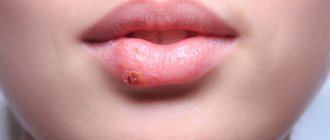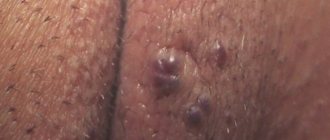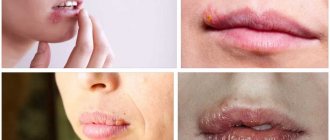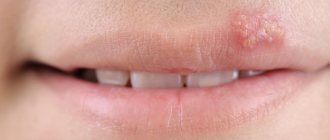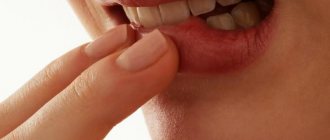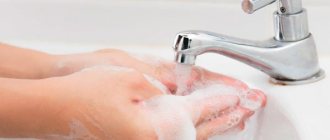- How is it different from a cold sore on the lips?
- How does infection occur?
- Causes of exacerbation
- Symptoms
- Treatment of herpes inside the lip
- When does herpes not need drug therapy?
Herpes inside the lip is a type of skin infection caused by inflammation of the herpes labium. The causative agent of the disease is herpes simplex virus type 1 (HSV-1).
Causes of exacerbation↑
Under certain conditions, herpes can become inflamed. The main reason for the exacerbation of the virus is weakening of the immune system. When the body's defenses are weakened, the infection enters the active stage. Due to the recurrence of herpes, inflammation appears on the mucous membrane of the lip.
Causes of weakened immunity:
- lack of vitamins;
- improper diet;
- frequent stress;
- smoking and alcohol abuse;
- hypothermia or overheating;
- excessive exposure to ultraviolet radiation;
- long-term use of medications;
- frequent colds;
- the presence of certain diseases that weaken the immune system.
Knowing the causes of herpes inflammation, you can avoid relapse. To maintain health, you need to maintain a stable immune system.
Symptoms↑
The symptoms of herpes labium are individual for each person. Its manifestations depend on the state of the immune system.
Most often, it manifests itself in the form of herpetic stomatitis. Namely, it causes inflammation of the oral mucosa or cold rashes on the lips. Sometimes accompanied by general weakness of the body (sometimes with an increase in temperature).
Inflammation occurs in 5 stages:
- stage. Mild itching or tingling occurs in the lip area. If you start treatment, you can avoid the appearance of bubbles.
- stage. It appears a couple of hours after the first stage. Irritation, swelling and redness form on the lip.
- stage. It comes in two to three days. Rashes in the form of small pimples form on the mucous membrane.
- stage. It appears within a few days. The bubbles burst and liquid flows out of them. It contains many herpes pathogens. During this time, the patient is prohibited from contacting others. Indeed, at this stage, it can easily transmit the infection through airborne droplets.
- stage. The wounds begin to heal. Complete healing occurs after ten days. The herpevirus then enters the latent stage.
The herpes virus should not be underestimated, because it can cause more dangerous diseases.
Fluid from bursting pimples can lead to stomatitis. This disease is difficult to tolerate, especially by children. HSV-1 also negatively affects the functioning of the liver, kidneys and nervous system. And acute stages can cause allergies.
The virus poses a particular danger to pregnant women. Inflammation of herpes in the first trimester can have a bad effect on the development of the child. Therefore, women need to be tested for the presence of the virus before planning pregnancy.
It seems that herpes on the inside of the lip is a disease that is more of a cosmetic nature and is not at all dangerous. However, in reality this is not the case at all! The fluid that is released from herpetic vesicles, especially at the 3rd stage of the disease, contains the highest concentration of the virus. This fluid inside the lip can spread the infection to other parts of the oral mucosa, which can cause herpetic stomatitis.
Stomatitis of this kind, especially in children, is fraught with dangerous complications, which often cause problems with the kidneys, heart, and nervous system. In addition, this virus poses a threat to infants, as it causes serious damage to children's immunity, which subsequently leads to frequent illnesses.
WHAT YOU NEED TO KNOW ABOUT HERPES SIMPLE
Key Facts
There are two types of herpes simplex virus: herpes simplex virus type 1 (HSV-I) and herpes simplex virus type 2 (HSV-II).
HSV-I herpes on the lips and facial area
transmitted primarily through oral contact and causes oral herpes (symptoms of which may include a “fever sore”), but can also cause genital herpes.
HSV-II herpes in the genital area
is one of the sexually transmitted infections and causes genital herpes.
More than 90% of the world's population are carriers of the herpes virus. Infection with both HSV-I and HSV-II lasts for life.
The frequency of herpes on the lips varies from person to person and can recur from 2 to 12 times a year. Most cases of herpes are oral and genital.
Typically, the virus settles in the body at 3-5 years of age, but does not appear until puberty.
Transmission routes:
- Autoinfection.
The virus is transmitted from infected areas of the body to uninfected areas. For example, contact lens wearers can transfer the herpes virus to the eye area by wetting the lenses with infected saliva instead of a solution.
- When contacting another person through a kiss
For infection to occur through a kiss, the virus needs 2 conditions:
so that the carrier has an active phase of herpes (moreover, it can be asymptomatic)
so that the partner has a predisposition to infection: an abundance of saliva, small wounds.
- Upon contact with a contaminated surface
The virus is able to survive for some time outside its host: in a humid environment, at a temperature of 37°. That is, it is possible to become infected by drinking from the same glass or using the same lipstick. It is theoretically possible, but rare, to become infected with genital herpes when sitting on plastic surfaces (toilet, locker room bench), because On plastic surfaces under favorable conditions, the virus survives for about 4 hours.
Stages of herpes
Precursor stage
It usually begins with a tingling, itching and burning sensation on the lips. Duration from several hours to 1 day.
Hyperemia stage
Literally on the same day as the tingling sensation, swelling and redness of the lip occurs. The condition is usually accompanied by itching and lasts on average 1-2 days.
Bubble stage
A group of several bubbles is formed, which merge with each other into one painful bubble filled with lymph. This usually happens on the second day and is accompanied by very painful sensations.
Stage of erosion formation
On day 3, the blisters transform into ulcers and pustules, which then form a sore. Usually it is gray in color with a bright red ring around it. The liquid released from the sore contains virus particles in a concentration of 1 million per 1 ml. and is highly contagious
Crust formation stage
From days 4 to 9, the sore dries out and crusts over. In this case, the pain becomes less, but severe itching appears. The sore may fall off in parts and bleed. Herpes begins to heal from the inside, the sore becomes smaller.
Healing stage
On days 9-11, the wound heals and heals. However, redness may persist for another two days. During this period, the virus returns to a dormant state, in which it can remain until it is activated again by risk factors.
Treatment
The most effective medications for people infected with HSV are antiviral drugs such as acyclovir, famciclovir and valacyclovir. They help relieve symptoms and reduce the frequency of their occurrence, but do not lead to a complete cure.
Prevention
HSV-I herpes on the lips and facial area
HSV-I is most contagious during the onset of oral herpes symptoms, but it can also be transmitted when no symptoms are felt or observed. Individuals with active symptoms of oral herpes should avoid oral contact with others and sharing objects that have come into contact with saliva. They should also abstain from oral sex to prevent herpes from spreading to their partner's genitals. People with symptoms of genital herpes should avoid sexual intercourse while they are experiencing symptoms.
Consistent and correct use of condoms can help prevent the spread of genital herpes. However, condoms can only reduce the risk of infection, since symptoms of genital herpes can appear in areas not protected by a condom.
Individuals already infected with HSV-I cannot become infected again, but they remain at risk of infection with HSV-2, which affects the genital area.
Pregnant women with symptoms of genital herpes should inform health care providers. Preventing new infections with genital herpes virus is especially important for women in late pregnancy, since this is the period when the risk of developing neonatal herpes is highest.
HSV-II herpes in the genital area
People with a genital infection caused by HSV should abstain from sexual activity while symptoms of genital herpes appear. HSV-II is most contagious when lesions appear, but it can also be transmitted when no symptoms are felt or observed.
Systematic and correct use of condoms can help reduce the risk of spreading genital herpes. However, condoms provide only partial protection because HSV can be found in areas not protected by a condom. Medical male circumcision can provide men with lifelong partial protection against HSV-II, as well as HIV and human papillomavirus (HPV).
Individuals with symptoms suggestive of genital HSV infection should be tested for HIV infection, and those living in areas with high HIV prevalence should be offered more focused HIV prevention interventions, such as pre-exposure prophylaxis.
Pregnant women with symptoms of genital herpes should inform health care providers. Preventing new infections with genital herpes virus is especially important for women in late pregnancy, since this is the period when the risk of developing neonatal herpes is highest.
Treatment of herpes inside the lip↑
It is impossible to get rid of the herpes virus entirely, because it is a permanent resident in the human body. However, transferring it into a long-term state of remission is quite possible. First of all, you need to monitor the state of your immune system.
Equally important is following a special diet. It is necessary to exclude products that irritate the mucous membrane of the lips:
- sweets;
- fatty foods;
- salinity;
- alcohol;
- caffeinated drinks.
If herpes is particularly severe, complex treatment using certain medications is indicated.
Criteria by which one can determine the rationality and effectiveness of complex therapy for herpes inside the lip:
- duration of the medical course of the disease;
- the occurrence of vesicular rashes or their elimination;
- the presence of granulations, which indicate the completion of the pathological process.
Doctors compare the criteria before starting treatment and after completing complex therapy. In addition, the timing of remissions between exacerbations of the disease and the incidence of complications are taken into account. Treatment of complex forms of herpes on the lips requires a more serious approach.
Antiviral drugs
If herpes does appear inside the lip, you need to use antiviral medications. As a rule, ointments like Zovirax, Acyclovir, etc. are prescribed. Of course, due to the fact that herpes is located on the inside of the lip, the drug may not be effective enough, since saliva is constantly secreted. However, despite this, lubricating and rinsing your mouth should be done at least 7-8 times a day.
Rinsing
The doctor also prescribes mouth rinse, most often with the drug “Stomatidin”. It has an analgesic and antiviral effect. Use the product undiluted. You can't swallow it! The medication is contraindicated for children under 5 years of age, as well as for pregnant women.
Typically the duration of the disease is 1-2 weeks. If the immune system is weakened, the disease may be prolonged. Herpesvirus can cause serious harm to the body, so it is better not to rely on self-medication, but to immediately consult a doctor. After examination, he will prescribe treatment, taking into account the individual characteristics of the patient’s body.
Complications of herpes on the lips
With mild or moderate inflammation, it disappears on its own. However, in infants and young children, for whom this is a primary infection, the symptoms of herpes on the lips and its consequences can become dangerous. But essentially this is due to the general primary infection of the child’s body with herpesvirus type 1.
Generalized infection. External symptoms are mild, but the general condition of a small child’s body resembles sepsis. Foci of infection are localized in the internal organs (lungs, liver, kidneys, spleen, brain), and can even lead to respiratory failure.
Transition to other organs and systems of the body. It is possible to transfer herpetic lesions to the skin, oral cavity, and eyes. In the visual system, inflammation of the cornea and conjunctiva (keratoconjunctivitis), as well as the retina and choroid (chorioretinitis) is possible.
Inflammation of the brain (encephalitis). The child has a high fever, severe lethargy, tense fontanel, convulsive seizures and coma are possible.
Reactivation of the virus (secondary infection) with symptoms of herpes on the lips can also lead to complications. Most often, the lesion spreads to the eyes - inflammation of the cornea (herpetic keratoconjunctivitis) with its clouding, scarring, visual impairment, even to the point of blindness.
An extremely dangerous complication is inflammation of the brain (encephalitis). In adults and older children, it can take an acute form, in which only three out of ten people survive without treatment.
When does herpes not need drug therapy?↑
There is no need to use medications for herpes on the inside of the lip if:
- it occurs less than 3 times a year;
- the illness lasts no more than 5 days;
- symptoms are limited to a small area of the lip.
In such cases, it is better to use traditional medicine, especially before the first signs appear, that is, immediately after the lip swells and the characteristic tingling begins. The most accessible and proven remedy is ordinary earwax. If you apply it to the affected area 1-2 times, sores may not occur at all.
To treat labial herpes at home, use tincture of white wormwood, essential oil of fir, cedar or tea tree, cut garlic cloves, and Kalanchoe juice.
